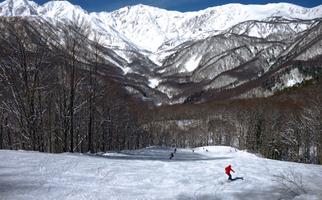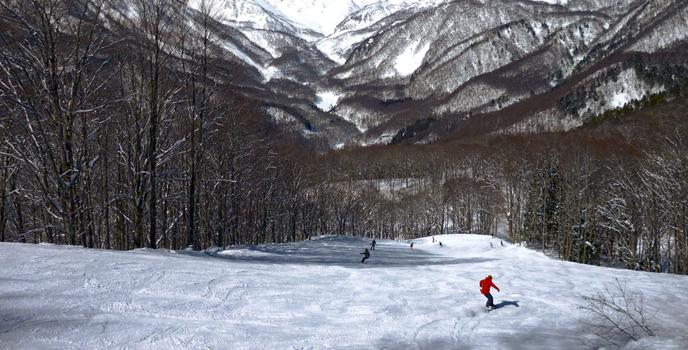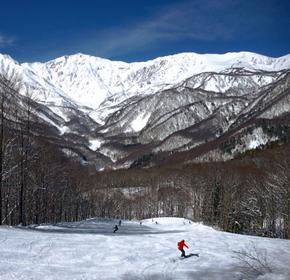
Hakuba travel guide
Hakuba Tourism | Hakuba Guide
You're Going to Love Hakuba
Many people flock to the city of Hakuba in the Japanese Alps to enjoy the many hot springs, winter ski resorts and hiking opportunities.
Top 5 Reasons to Visit Hakuba
1. Hakuba Happo-One
This ski resort is one of the most famous in the Japanese Alps, with runs ranging from beginner to Olympic pro.
2. Juro No-Yu
These hot spring mineral baths are open 24 hours a day between December and March and are located near Kamishiro station.
3. Goryu
In the summer this top ski run becomes an alpine garden, with trails letting you hike to other parts of the mountain ranges.
4. Aoki-ko, Nakazuna-ko and Kizaki-ko
These clean freshwater lakes allow for water sports such as sport fishing, windsurfing, swimming and boating.
5. Chōkoku-ji Temple
This Buddhist temple houses treasures from the Heian Era and conducts daily meditation services and sermons for visitors.
What to do in Hakuba
1. Hakuba's Premier Alpine Extravaganza
Happo One (or Happoone) is a huge ski resort a couple of miles from Hakuba which shot to fame in 1998 during the Nagano Olympics (which could more accurately be called the Hakuba Olympics). The slopes at Happo One hosted the downhill Alpine skiing, the giant slalom and combined slalom events, while the ski jumping took place next door. These days, the competitors are long gone, but the crowds keep coming to a beautifully maintained, professionally run resort which commands gorgeous views of the mountains beyond.
2. A Peak That Will A-Send You To Heaven
A few miles past Happo One, you can't miss Mount Shirouma, which stands 2,932 meters high and dominates the Hida Mountains. In the summer, the slopes are festooned with colorful Alpine flowers, making it an appealing place to hike, while the slopes are full of skiers and other Alpine enthusiasts when the snows arrive. One of the most popular climbs in Japan due to its relatively easy path and convenient time scale, Shirouma has camps and way stations along the ascent, so it's well worth considering a hike.
3. Cherry Blossoms, Fireflies, And Outdoor Recreation
Back down at ground level, or near enough, Lake Aoki is a beauty spot located about 8 miles south of the resort itself. Classed as one of the "Three Lakes of Nishina" and shaped roughly like a heart, Aoki is a water sports paradise in the summer, when you can kayak, sunbathe and, of course, swim in its placid waters - with the mountains forming a remarkable backdrop. On summer evenings, the lake becomes illuminated by fireflies, while winter brings colonies of migratory birds, and spring colors the lakeside with cherry blossom hues. It's a magical place to unwind in any season.
4. Thermal Springs In A Stunning Setting
Few onsens (thermal spring resorts) are as spectacularly situated as Yari, which is perched 2,100 meters above sea level. The springs here have been sculpted into a stunning pool with views across the valley, and resembles the kind of "infinity" pool found at upscale hotels. And, despite the cool climate of the high slopes, it's always warm and inviting. The only snag is that Yari is accessible only by foot. Visitors need to drive to Sarukura and hike around 5 hours to the onsen, but few people regret the decision to do so.
5. A Cute Olympic Retrospective
They don't make a massive deal out of the Nagano Olympics in Hakuba, but they do have this small but absorbing museum which captures some of the excitement of the event. Photo displays and memorabilia have a nostalgic flavor, but give a good idea of what hosting the Games meant to little Hakuba. The ski jump is nearby, and visitors can ascend to the summit, reliving the anticipation and nerves of 1998's contestants, albeit without the 45,000 spectators cheering them on.


1. Hakuba's Premier Alpine Extravaganza
Happo One (or Happoone) is a huge ski resort a couple of miles from Hakuba which shot to fame in 1998 during the Nagano Olympics (which could more accurately be called the Hakuba Olympics). The slopes at Happo One hosted the downhill Alpine skiing, the giant slalom and combined slalom events, while the ski jumping took place next door. These days, the competitors are long gone, but the crowds keep coming to a beautifully maintained, professionally run resort which commands gorgeous views of the mountains beyond.
2. A Peak That Will A-Send You To Heaven
A few miles past Happo One, you can't miss Mount Shirouma, which stands 2,932 meters high and dominates the Hida Mountains. In the summer, the slopes are festooned with colorful Alpine flowers, making it an appealing place to hike, while the slopes are full of skiers and other Alpine enthusiasts when the snows arrive. One of the most popular climbs in Japan due to its relatively easy path and convenient time scale, Shirouma has camps and way stations along the ascent, so it's well worth considering a hike.
3. Cherry Blossoms, Fireflies, And Outdoor Recreation
Back down at ground level, or near enough, Lake Aoki is a beauty spot located about 8 miles south of the resort itself. Classed as one of the "Three Lakes of Nishina" and shaped roughly like a heart, Aoki is a water sports paradise in the summer, when you can kayak, sunbathe and, of course, swim in its placid waters - with the mountains forming a remarkable backdrop. On summer evenings, the lake becomes illuminated by fireflies, while winter brings colonies of migratory birds, and spring colors the lakeside with cherry blossom hues. It's a magical place to unwind in any season.
4. Thermal Springs In A Stunning Setting
Few onsens (thermal spring resorts) are as spectacularly situated as Yari, which is perched 2,100 meters above sea level. The springs here have been sculpted into a stunning pool with views across the valley, and resembles the kind of "infinity" pool found at upscale hotels. And, despite the cool climate of the high slopes, it's always warm and inviting. The only snag is that Yari is accessible only by foot. Visitors need to drive to Sarukura and hike around 5 hours to the onsen, but few people regret the decision to do so.
5. A Cute Olympic Retrospective
They don't make a massive deal out of the Nagano Olympics in Hakuba, but they do have this small but absorbing museum which captures some of the excitement of the event. Photo displays and memorabilia have a nostalgic flavor, but give a good idea of what hosting the Games meant to little Hakuba. The ski jump is nearby, and visitors can ascend to the summit, reliving the anticipation and nerves of 1998's contestants, albeit without the 45,000 spectators cheering them on.


Where to Eat in Hakuba
Soba Shubo Zen offers Asian and Japanese food, including noodles, sashimi and goza. Meal prices cost roughly JPY1,200.
When to visit Hakuba
The best season to visit is during the winter when the many popular ski resorts open, offering visitors an opportunity to indulge in many snow sports.
How to Get to Hakuba
Plane
Narita Airport near Tokyo is the closest airport, with one way tickets from London costing JPY60,000.
Train
Take the JR Oito Line or the Shinkansen (bullet train) from Tokyo, depending on your time schedule. The former takes 4 hours and is JPY8,000 one way, while the latter takes just over 2 hours and costs JPY9,700.
Car
From Tokyo, take the Highway 20 and Chuo Expressway to reach Hakuba in roughly 3.5 hours.
Bus
There are several daily buses from Tokyo that make the trip to Hakuba in 4.5 hours and costs JPY8,500 for a roundtrip.
Airlines serving Hakuba
Where to stay in Hakuba
Mt. Shirouma - There are many trails and runs located around the mountain that offer world-famous skiing opportunities.
Popular Neighborhoods in Hakuba
Iwatake - Here you can practice on the dry ski slopes during the off-season or take in the thousands of lilies that grow during the summer.
Aokiko - In the summer you can take a lift here to take advantage of the popular sport of mountain biking.
Where to stay in popular areas of Hakuba
Most booked hotels in Hakuba
How to Get Around Hakuba
Public Transportation
Genki-Go shuttle buses run throughout Hakuba for JPY300 a ride.
Taxi
There are very few taxi cabs in Hakuba, as there are frequent shuttle buses and everything is within close walking distance. Taxi tariffs start at around JPY500.
Car
Rental vehicle prices start at about JPY7,500 a day and can be picked up from the Kamishiro station.
The Cost of Living in Hakuba
Shopping Streets
The majority of tourist souvenirs and ski gear can be bought from the ski resort gift shops. There is currently no major shopping mall in Hakuba.
Groceries and Other
Tsuruya and Matsuya are the main supermarket chains selling food for self-catering. A dozen eggs costs around JPY180.

